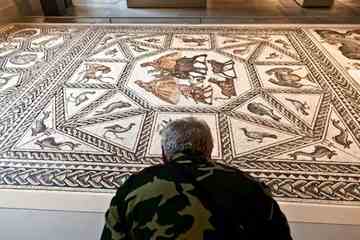In 1996, workers in Lod, Israel, were preparing to expand a road when they found something that turned out to be an artistic and archeological treasure: a Roman mosaic from about 300 A.D. Preserved just three feet below the modern surface, it was in nearly excellent condition.
 On view beginning Tuesday at the Metropolitan Museum of Art (through April 3), the mosaic—50 feet long by 27 feet wide—looks slightly larger than some Manhattan apartments. It is believed to have been used as an interior ground cover for an entrance hall at the home of a wealthy Roman, living in what would have been the eastern portion of the Roman Empire.
On view beginning Tuesday at the Metropolitan Museum of Art (through April 3), the mosaic—50 feet long by 27 feet wide—looks slightly larger than some Manhattan apartments. It is believed to have been used as an interior ground cover for an entrance hall at the home of a wealthy Roman, living in what would have been the eastern portion of the Roman Empire.
Curator Christopher S. Lightfoot explained that the clue to determining that the mosaic was originally housed indoors was that its surface was perfectly flat when found. If it had been used outside, rain water would have run off the tiles and altered the plane.
The most unusual facet of the mosaic is that it depicts no humans—and no religious symbols. One of the three panels is devoted to fish, shells and other marine life, plus two boats. Wild animals—such as a bull, elephant and giraffe —occupy the center and north panel, and may allude to the owner's ability to host gladiatorial games, in which animals like tigers and lions were used. Smaller creatures—such as birds, fish and rabbits—are also included, as well as repeated shapes used to frame the animals.
 There is one portion of the mosaic, about the size of a flattened beach ball, that is not intact, but the damage was not incurred during the preservations. Experts believe it occurred in the 18th or 19th century.
There is one portion of the mosaic, about the size of a flattened beach ball, that is not intact, but the damage was not incurred during the preservations. Experts believe it occurred in the 18th or 19th century.
The Met exhibit is accompanied by a short video that shows the delicate process of gluing and lifting the mosaic, in 2009, out of its original space, as well as moving it into a studio where it could be cleaned and preserved.
The Met is the first institution to show the work, which is situated in the Greek and Roman Galleries near large windows that allow natural light to shine directly on it. Amid the marble sculptures, this richly colorful mosaic seems to emphasize the human connection between ancient and modern life: But it doesn't just illustrate the wealth of its owner—footprints belonging to the workers who installed it more than 1,700 years ago were found beneath the tiles.
Author: Pia Catton | Source: The Wall Street Journal [September 28, 2010]